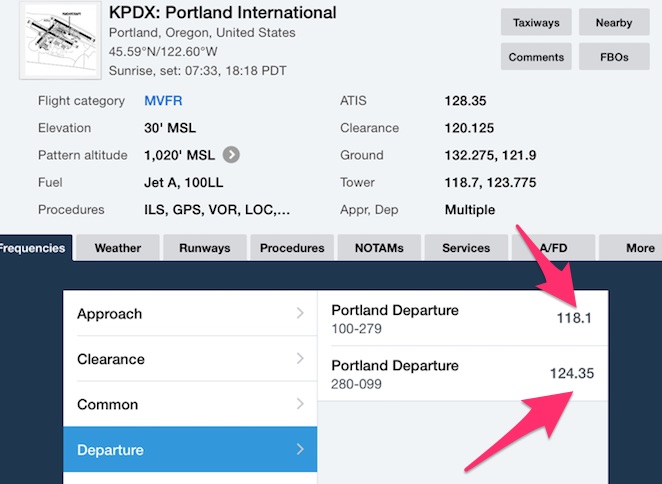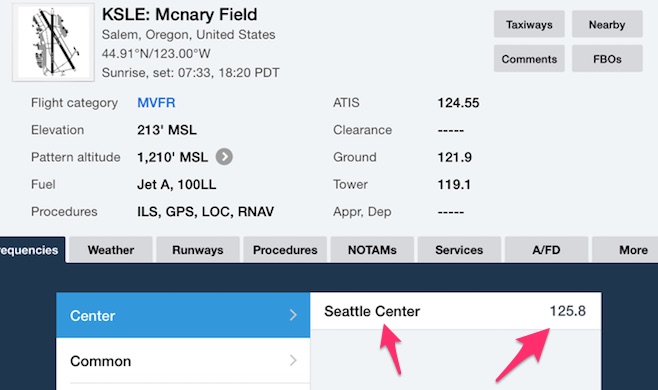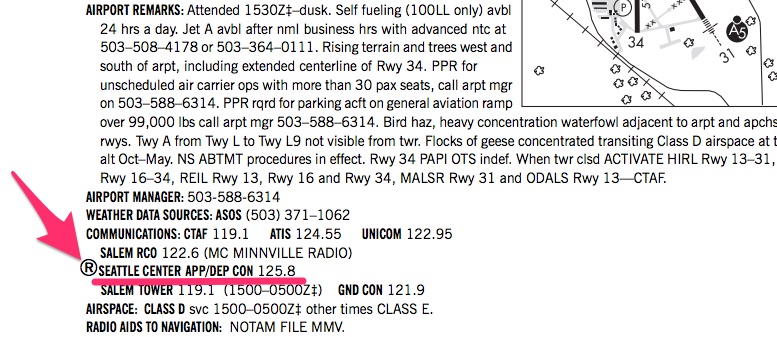Picking up flight following is a critical final step in the VFR flight planning process. On cross country flights, the sequence of events starts with planning the flight, filing the flight plan, opening it with nearest flight service station (FSS), and finally requesting flight following with air traffic control (ATC) .
It’s one thing to feel comfortable filing and opening a VFR flight plan. That’s the mark of an average pilot. Really great pilots on the other hand can comfortably pick up VFR flight following, and they make it a habit.
If you need a refresher on how to file, open and close VFR flight plans, check out these articles.
Now that you’ve gotten a refresher on VFR flight plans. Let’s cover the basics of flight following and then get into the details on exactly how to pick up flight following.
What is VFR Flight Following?
Flight following is a radar service provided by air traffic control. Its official term according to the AIM (4-1-14) is Radar Traffic Information Service.
The advantage of flight following, however, isn’t necessarily the traffic alert services. Any pilot with an iPad, the Foreflight app, and a Stratus, can do their own traffic avoidance.
The reason pilots should always get flight following is it provides real-time aircraft tracking.
They can help you immediately in an emergency immediately. They can give you weather updates, vectors out of inadvertent icing conditions. Whatever situation you’ve gotten yourself into, they can try and help.
In addition, pilots in distress will get faster and more accurate search and rescue services.
For pilots who elect to open a flight plan, but don’t follow it up with the critical last step of flight following, no one will search for them for at least 30 minutes after the arrival time. That could be hours depending on the flight plan.
With flight following, however, ATC will initiate SAR right away if you declare an emergency.
The only way to get some semblance of flight following without actually contacting ATC is to purchase a Spot Tracker or Garmin InReach GPS. With a subscription plan, pilots can easily send out a distress signal with their exact coordinates in an emergency.
What are the responsibilities of the pilot during flight following?
The AIM goes to great lengths to remind pilots that radar services “is not intended to relieve the pilot of the responsibility for continual vigilance to see and avoid other aircraft.” (AIM 4-1-14).
In other words, you have to pay attention!
Yes, ATC will tell you of approaching traffic, however, they will not automatically vector you. They also can’t locate the traffic for you, that’s your job.
There are a few other things pilots must do:
- Maintain VFR cloud clearances. Flight following is NOT an IFR clearance.
- Monitor the radio. This gets a lot of VFR pilots in trouble if they aren’t used to monitoring the radio on long flights. The whole point is to get traffic alerts, so listen!
- See and avoid traffic. ATC will give you a cardinal direction, but it is the pilot’s job to locate and avoid the traffic.
- See and avoid terrain. ATC will issue terrain alerts, but the responsibility rests solely with the pilot to avoid the terrain.
Is flight following the same as opening a flight plan?
Short answer: No
Flight following is NOT the same as filing and opening VFR flight plan. They are independent of each other.
The main difference between opening a flight plan and flight following is who you talk to and how long you talk to them.
Pilots must open and close their flight plan with the Flight Service Station (FSS). Once the flight plan is open, you don’t need to monitor the FSS again until you’re ready to close your flight plan. (and if you use Foreflight, you never need to talk to the FSS)
When pilots get flight following, however, they’ll speak to Air Traffic Control.
ATC and the FSS are two different entities with two very different jobs.
The FSS deals with flight plans, NOTAMs, weather, PIREPs, and monitoring NAVAIDs.
ATC doesn’t deal with any of that. They are dealing with the aircraft right now as they fly through the air. They vector IFR traffic, issue approach clearances, landing clearances, traffic alerts, and coordinate with other controllers.
Therefore, I should note, flight following does NOT open your flight plan. You must call to open your flight plan through the FSS, then you can call Center and get flight following.
Check out my article on how to open a VFR flight plan for more information.
Now that we cleared that up, let’s get into the meat of the procedure:
How do you pick up flight following?
First and foremost, you need the right frequency for Center or Departure.
That’s right, you won’t be talking to the tower, or the FSS. You will be on the same frequency as the airline pilots.
How do you find the frequency for flight following?
Depending on the airport, you will either contact either “Departure” or “Center” after you get to a high enough altitude.
Pro Tip: Identify and write down Center/Departure’s frequency on your kneeboard before you take off.
Here are examples of how you find the frequencies in Foreflight and Skyvector.com
Foreflight example:
(P.S. I can’t live without this program! If you don’t have an iPad, go get one just so you can use this program. I did)
Portland has two departure frequencies. Use the one appropriate to your departure heading. For example, if you are heading north-ish use 124.35, and if you are going south-ish use 118.1.
Don’t worry. If you mess up they will tell you to contact the other frequency. Still, do your best to get the right one.
Salem is a smaller Class D airport so you will go straight to Seattle Center.
If you don’t have Foreflight, you can use Skyvector.com, a free planning tool. Enter the airport identifier and you will see this:
Type in your departure airport into Skyvector. In the upper left-hand corner, you will see the Airport/Facility Directory.
Click on the Airport/Facility Director. It will take you to this:
In the Airport/Facility Directory, you will see the controlling center’s frequency. That’s the frequency you will use to pick up VFR flight following.
Don’t confuse this frequency with the one above it for the FSS (in this case McMinnville Radio).
Remember, the FSS opens your flight plan, but Center APP/DEP will give you flight following.
What altitude should you fly at before you pick up VFR flight following?
This is a trick question. Pilots can pick up flight following on the ground prior to takeoff, but if you choose to do it in the air, here you go:
I suggest you wait until at least 1,000 feet above ground level (AGL) before calling to ensure the best reception.
I think it’s always a good practice to get to a safe engine-out altitude before you mess around doing anything, including checklists. Just hold your horses for a minute.
Out West, you may have to climb even higher in mountainous terrain. How do you know how high?
Ask tower. No tower? Ask a pilot at the FBO. No pilots or you are shy? Did you fly into the airport with flight following? Before you land, ask what altitude they can usually hear pilots.
Note: Remember, just because they can hear you, doesn’t mean they have radar coverage. You may have to adjust your planned VFR flight plan altitude in order to get flight following.
Flight following is kind of useless without radar coverage. But stick with it because you will get back into radar coverage eventually.
For example, as I flew into Medford, OR (KMFR) the other day. I was up with Center on an IFR flight plan, so I asked them how high I’d have to fly on my next leg up to Redmond, OR (KRDM).
Center told me they lose aircraft below 7,000 feet MSL. I was in a dual engine helicopter, and who wants to fly high in a helicopter? So, I decided not to get flight following for my VFR flight up to Redmond.
I didn’t make the safest decision, but that’s aviation. I knew the risk. I was also with another pilot and we had two engines.
The best way to mitigate the risk of poor radar coverage is to fly with a Spot tracker. Search and Rescue will find you in a heartbeat with the Spot Tracker. I cannot speak highly enough of using this product or some other real-time tracking device.
As a search and rescue pilot, I have flown days looking for crashed pilots. With a Spot Tracker, we could have found them immediately.
What is the proper radio call to pick up VFR flight following?
VFR pilots always seem to mess up this call. This is what it should look like:
Give ATC a heads up:
“Center, Cessna 12345, with request.”
It’s very important to give them a heads up because unlike all of the IFR traffic, they are not tracking you at all. They don’t know who you are, where you are or what you want.
They are not thinking about you, so say hello first.
“Cessna 345, go ahead.”
Hopefully, they shortened your call sign to only three numbers and/or letters. If they didn’t then you must continue to use the full call sign until ATC shortens it.
Give them your info and request:
“Cessna 345, is a Cessna 182, at 5,500 feet, 5 miles north of Salem airport, Sierra, Lima, Echo, request flight following to Medford airport, Mike, Foxtrot, Romeo.”
Okay, so this is the part I hear get messed up all the time. These are the key elements of this call:
- Callsign
- Use the full call sign until ATC shortens it. Ideally, skip the “N” prefix and instead use they type of aircraft you are flying (ie. Cessna, King Air, Mooney)
- Check out this excellent article on call signs and when you can shorten them: ATC Communications.
- Type of aircraft
- They need to know the performance ability of your aircraft.
- Altitude
- If you are on their radar this info will help them identify you.
- If you are climbing you will need to add that info into the call. Simply say “3,500 climbing to 5,500” instead of the example I gave which assumes you have leveled off at 5,500 feet.
- Location: this can be off an airport, VOR, fix or waypoint.
- If you are a VFR pilot, it’s probably best just to use airports and VORs as you won’t be that familiar with IFR waypoints and fixes.
- Don’t make the call until you know the distance!!! Or you could just say “vicinity of.” So many pilots key the mike and then have to think about where they are. Don’t be that guy.
- ATC uses this info to identify you on radar. They have a lot of aircraft flying around.
- Request: ask for flight following
- Use the phonetic alphabet to spell your destination airport. Seriously! You know the small airport, but ATC probably won’t.
ATC will come back and make a note of your location, give you a squawk and probably an altimeter setting:
“Cessna 345, radar contact 5 miles north of Salem, squawk 4589, the Salem altimeter is 29.95“
You need to acknowledge this call by repeating the required elements and ONLY the required elements.
What are the required elements?
In this case, you need to acknowledge they have the right location by saying “position checks.” You also have to say the squawk and ATIS numbers as per the AIM.
“Position checks, squawk 4589, and 2995, Cessna 345“
Notice how I shortened this call and cut out the extraneous information? It’s important to tighten up your radio calls to only the essential elements when dealing with Center. They are very busy.
Your professionalism on the radio will directly affect your ability to get flight following.
Don’t repeat everything back word for word. ATC knows 2995 is referring to the altimeter setting.
Pro Tip: Wait and listen at least 4 seconds before you call. Waiting 4 seconds is a foolproof way of not stepping on anyone.
What do you do once you have flight following?
There are three main things you must do when you have flight following:
- Put the assigned squawk in your transponder
- Continue to listen for traffic updates.
- Unlike opening a flight plan, you now have to actively listen and respond to ATC when they give you a traffic advisory. This is the biggest mistake I hear VFR pilots make on the radio.
- ATC: “Cessna 345, traffic at 9 o’clock, moving west at 3,500 feet.“
- YOU: “Negative contact, Cessna 345” or “Traffic in sight, Cessna 345.“
- PAY ATTENTION! Please, pay attention when you are up flight following. If you want to zone out and listen to music with your blue tooth headset, then don’t pick up flight following.
- Cancel flight following when you have your destination airport in sight.
- YOU: “Cessna 345, airport in sight, cancel flight following.“
- ATC: “Radar services terminated, squawk VFR, switch to advisory frequency.“
- YOU: “Squawk VFR, going to CTAF.“
That’s all there is to it.
Do you fly out of a Class C or B airport? Keep reading, because there are some advanced ways to get VFR flight following.
How to request flight following on the ground.
I fly out of Portland, OR, a class C airport, and I heard a pilot ask for flight following before he even left the ground. I was floored! I’d never heard of that before. That’s even possible to ask tower for flight following?
Yes, you can pick up flight following through tower, on the ground prior to takeoff (even at Class D airports).
Most (or all, I’m not totally sure) Class C airports, want to know who is departing their airspace whether they are on IFR flight plans OR VFR flight plans.
So, they will require all VFR traffic to call Clearance delivery for a squawk prior to takeoff. And since you are already talking with them, you might as well get everything out of the way on the ground.
Note: This does NOT mean they are opening your flight plan. You will still need to do that through the FSS either on the ground prior to departure (preferably prior to taxiing because you will be too busy at a Class C airport), or in the air.
Give it a try sometime.
Final thoughts
Don’t be intimidated by flight following. Make it a habit and you will quickly get used to the radio calls.
Flight following could save your life!
Additional Reading:
Radio Mastery for VFR Pilots by Jeff Kanarish




